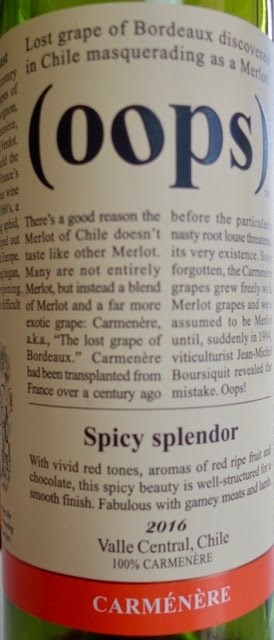Normally I say “oops” when I’ve made a dumb mistake, like, “Oops, I’ve just realized I’ve been driving my car for the last three months without any car insurance!” Yes, it really happened and it took an alert motorcycle cop to make me aware of it. Luckily I wasn’t in an accident!
Today I’m using oops to recommend a tasty affordable wine. Its name is Oops and it’s a 2016 Carmenere ($12.99) from Chile. Carmenere is the “lost grape” of Bordeaux which was discovered in Chile 24 years ago masquerading as Merlot.
Originally from Bordeaux, France it was shipped to Chile in the 19th century and the locals thought it was Merlot. Carmenere eventually died out in France because of the insect disease, phylloxera.
Meanwhile in Chile, winemakers planted this Merlot impostor with the real Merlot and blended them together calling it Merlot. No wonder it didn’t taste like any other Merlot in the world. It wasn’t until 1994 that Jean-Michel Boursiquit, a clever viticulturalist, realized it was actually Carmenere. Oops!
Although Merlot is a noble grape, Carmenere is just as good and in fact tastes like a cross between Merlot and Cabernet Sauvignon. The 100 per cent Carmenere has a gorgeous ruby red colour and a red fruit and herbal bouquet. The flavour is rich with ripe raspberry and blackberry and is silky smooth with a dry finish. Very good quality for the $12.99 price tag! Rack of lamb anyone?
From Chile, we now go to Germany’s Mosel Valley to unscrew a 2015 My Karp Riesling ($19.99). It’s produced by the Karp family who have over 300 years of winemaking expertise. And when you look, sniff and swallow, you’ll realize that they know what they’re doing when it comes to making excellent wine.
I was surprised that this Mosel would have such a golden colour. Normally Mosels in this price range are almost colourless. The fact that it is three years old, partly accounts for the golden colour, as does the amount of ripeness when the grapes were picked.
My Karp’s bouquet is generous with honey and ripe tree fruit, much like you would experience with a sweet late harvest wine. But this is quite dry. Even though it has a sweetness rating of 2 out of 10, the high amount of acid from the Riesling grapes keeps the sensation of sugar to a minimum. And the sugar tones down the acid to a refreshing level.
Furthermore, My Karp’s dry flavour is rich like a late harvest wine, fruity with ripe apple and apricots. With a picture of a carp on the My Karp label (pun intended), it would go well with fish, especially sushi or poké. And a roast pork shoulder with au jus made from the pork drippings, chicken stock, sage and a splash of My Karp would be delicious with this Riesling.
Bon Appetit, Beber, and Prost!
Eric Hanson is a retired Richmond teacher and a wine educator.
[email protected]



